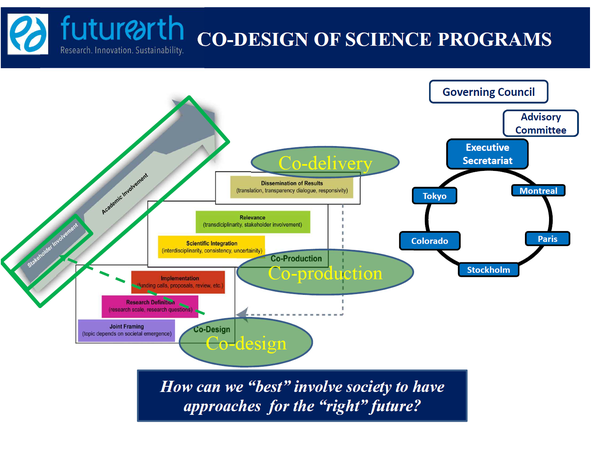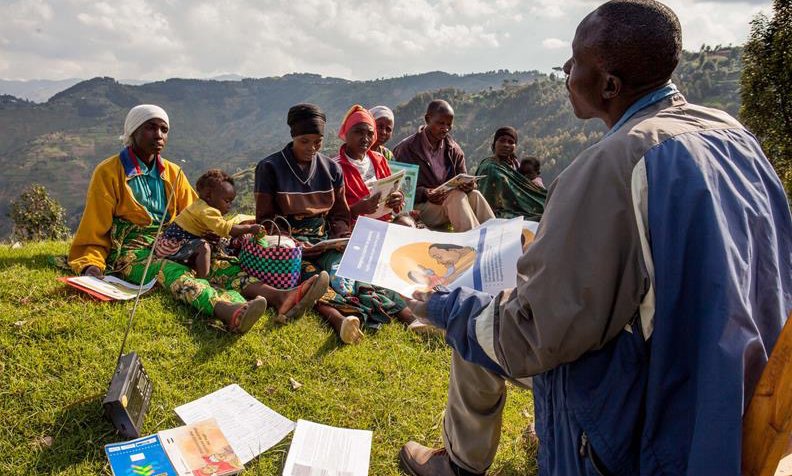How the Future Earth Project can reach its full potential
by Professor Tim O’Riordan OBE FBA
24 Aug 2018
Scientific evidence has been showing that humanity is straying near or past safe boundaries in the areas of climate change, biodiversity loss, nutrient cycling, and ocean acidification. The international research platform, Future Earth, aims to provide the knowledge and support to accelerate long-lasting transformations to a sustainable world through interdisciplinary research.
Five years on from the creation of the UK Future Earth National Committee, the different strands of the global Future Earth project will be brought together at the Future Earth Summit in Bonn to take stock of the objectives and mechanisms under its new leadership. This meeting will look at the interfaces between Global Research Projects, Knowledge Action Networks and National Committees, and the ways in which the reinvigorated Future Earth can support and promote integrated science, cooperative solutions delivery, and comprehensive communication.
My belief is that Future Earth is not yet living up to its potential. It is not optimistic enough about what can be done to move towards meaningful sustainability, and it is not capturing the hearts and minds of young people who should be the main beneficiaries – and key drivers - of its efforts.
Let me summarise what I hope emerges from the Bonn meeting:
1. A positive vision for Future Earth.
Much as I admire the work of the resilience community on “limits”, “boundaries” and “hothouses”, I cannot but feel that the messages being conveyed are both pessimistic and doom-laden. If Future Earth is to capture hope and pride in being a citizen of Planet Earth, then it must show how it is possible to change the worst of things and to work together to re-organise people, perspectives, processes, and practicalities towards betterment and overall wellbeing. Diagnoses should be precursors to prognoses. Of course, most of the transformative arrangements will be very difficult to achieve: we all know that. The beauty of the Future Earth approach lies in its comprehensive cooperativeness, its search for mutual appreciation and understanding, its step by step ways of proceeding, and the championing of the small local initiatives which coalesce into a sustainable planet. Indeed it is also positing a moral perspective on the need for decency, for fairness, for tolerance, and for sensitivity to the due rights of others alive and still to arrive.
Let us look for ways to tackle the blockages, to show that there are solutions, some of which are already in place but not appreciated, and create battalions of citizen and academic researchers working arm in arm to take these solutions forward. Future Earth is a process of partnership transformation and honest learning, where the most difficult ideological and institutional friction points are courageously confronted and sensitively addressed.
2. Confidence-building for the next generation of researchers.
The British Academy and the Paris office of Future Earth Global combined to host, earlier this year, a highly successful meeting of early career researchers to provide networks and support. This was a great event and gave much heart and confidence for a small and committed group and it should be replicated all over the academic world. It would be wonderful if Future Earth was internationally recognised as a breeding ground of transdisciplinary action-driven researchers working in teams of change agents as catalysts for progressive transformation.
For this vision to expand, it is vital that there are research and funding opportunities specifically for interactive and integrated programmes embracing researchers inside and outside academia in solutions generating activities. One of the most important aspects of the reconstituting Future Earth is surely the grounding it gives to its next leadership.
3. Sustaining the sustainability transition.
In our enthusiasm to reach sustainable development goals we can forget, or possibly fail to examine, the many “costs” of getting to sustainability. There is no pain-free pathway. We do not always seem to appreciate who may be the “losers” and how they may feel about their plight, and about sustainability more generally. The losers are everywhere: from the huge and often impoverished workforces in fossil fuel extraction, to the foresters operating often in brutal conditions, to the far-flung fishing fleets, to the previously “innocent” manufacturers of non-recyclable plastics.
Future Earth surely must address forms of economy, of incentives, of pools of training and community relocation funds, all intimately linked to SDGs, and all suited to a veritable maze of cultural and geographical conditions. Behind all of this is the consumer, the supposed mainstay of economic renaissance, who is being buffeted by: lower real incomes, the prospect of tax-hiked goods to pay for carbon and biodiversity hits, requests to “satisfice” rather than to “satisfy”, and in many cases seeking to retain employment in the manufacturing, services and retail sectors whose survival at present depends upon unsustainability. Crafting positive stories and solutions out of sustaining sustainability will test Future Earth to its current limits.
4. Communicating the uncommunicable.
One feature of Future Earth is its unfamiliar and often uncomfortable messages, even when it is seeking to offer hope. The target audiences are least approachable if they are not involved with forming the messages they receive. Getting the adherents of many different perspectives to understand and appreciate each other is an unresolved challenge for Future Earth. Working through community networks, sensitising like-minded people to reach out to those of potentially the same persuasion, and enabling intermediaries in various cultural networks to “translate” key messages and actions and moral responsibilities will prove to be the greatest test for the success of Future Earth as well as its greatest achievement as it begins a process of true communication.
This is a gap that connects the three themes outlined above. To bring this quartet together would surely be a triumph for Future Earth.
5. More interconnectivity
The fundamental distinctiveness of Future Earth lies in this diagram.

Even this image is not quite comprehensive. The roles of academia and stakeholders should be much more interconnected, almost to the point of fusion. The excitement of transdisciplinarity where the creative arts, the sciences and the social sciences merge into a more holistic methodology and action space is absent. The concept of science as a knowledge broker and a process of mutual enlightenment amongst all citizens, and hence a means of continuous learning and communication, is given too little emphasis.
The irony here is that while there is an embrace of the international sciences and social sciences councils, the humanities and creative arts are left aside. Nor is there the same empathy of scientific connectivities in higher education, in the academies, or in the research roles of the coming generation of Future Earthers. Indeed, there are still impediments to early career researchers who wish to establish themselves on the Future Earth platforms.
There are genuine efforts to widen and deepen the characteristics of connected research through policy action programmes, work experience arrangements and internships. However, there is still no general confidence building process to enable an emerging researcher to develop through the Future Earth framework and break into the exciting territory of change agency. I hope the Summit will successfully address these issues and continue to advance the identification and definition of major Global Systemic Challenges.
Professor Tim O’Riordan OBE FBA is Emeritus Professor of Environmental Sciences at the University of East Anglia.


